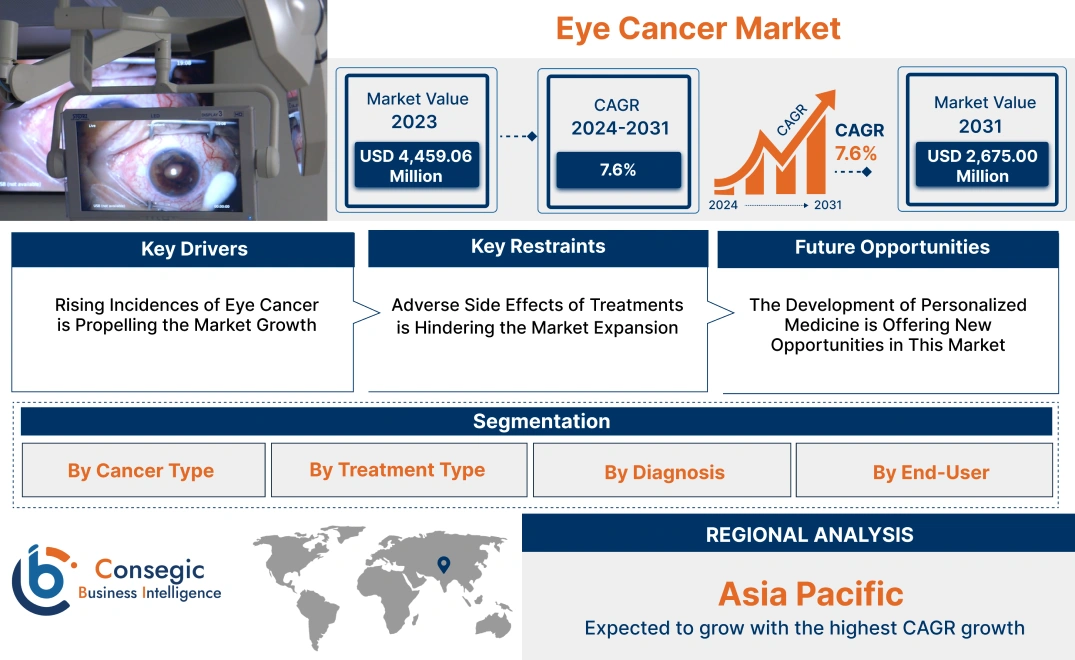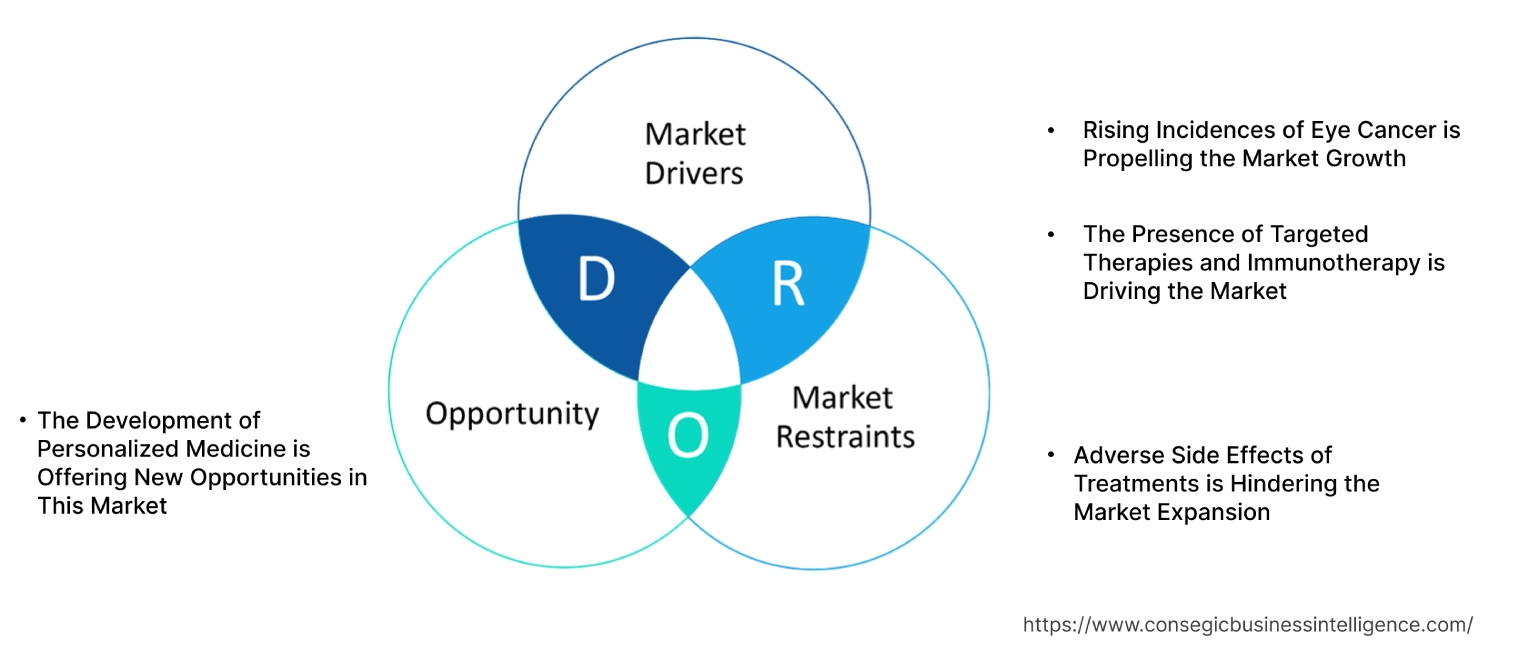Eye Cancer Market Size:
Eye Cancer Market size is growing with a CAGR of 7.6% during the forecast period (2024-2031), and the market is projected to be valued at USD 2,675.00 Million by 2031 from USD 4,459.06 Million in 2023.
Eye Cancer Market Scope & Overview:
Eye cancer basically represents malignancies that arise from the tissues within the eyes. It is classified according to its location of growth. Starting with intraocular melanoma, retinoblastoma, conjunctival malignancy, lymphoma, and squamous cell carcinoma. Possible symptoms that manifest themselves include change in vision, eye pain, redness, and swelling, and the possibility of seeing floaters and flashes of light. Diagnosis is carried out through eye examination, imaging, and at times biopsy. As a branch of the healthcare sector, the eye cancer market deals with the identification, prevention, and cure of eye cancer. This market includes several segments such as active pharmaceutical ingredients, medical equipment, and diagnostics.
Eye Cancer Market Insights:
Eye Cancer Market Dynamics - (DRO) :
Key Drivers:
Rising Incidences of Eye Cancer is Propelling the Market Growth
There are several types of eye cancer, which consequently increases the need for efficient diagnostic methods and equipment. Modalities like CT scans, MRIs, as well as diagnostic methods, including biopsies are used more often for diagnosing cancer correctly. Targeted therapies are designed to be selectively toxic to cancer cells and spare healthy tissues as these therapies incorporate personalized medicine into therapy regimes. More cases of cancer mean that more patients seek surgical, radiation, and chemotherapy treatment, and new trends such as immunotherapy. This leads to an expansion in the demand for pharmaceutical products, medical equipment, and treatment facilities.
- In January 2024, liquid biopsy was used since it allows melanoma tumor cells to be retrieved from blood samples rather than making a cut or inserting a needle into the eye. It was primarily done as part of a clinical trial.
Therefore, the market analysis shows that the rising incidence of eye cancer includes increased demand for diagnostic and treatment services, expansion of healthcare facilities, investment in research, enhanced awareness, and screening programs.
The Presence of Targeted Therapies and Immunotherapy is Driving the Market
These are treatments specifically designed to act upon cancer cells based on a particular set of molecular or genetic characteristics without interfering with other healthy cells. Targeted therapies have been adopted and more plans and favorable outcomes in patients with eye cancer because of the characteristics of examining specific mutations or molecular pathways. Targeted therapies and immunotherapy are, considerably safer compared to chemotherapy and radiation therapy, and any side effects, which they might have, are usually fewer and less severe. This better tolerability enhances the patient's quality of life and therefore encourages such therapies.
- In 2024, in the laboratory monoclonal antibodies have been engineered to identify and bind to certain protein markers present on the outside of certain cancerous cells. Monoclonal antibodies are mostly used to treat advanced eye cancer.
Therefore, as per the market analysis, targeted therapies and immunotherapy represent a significant advancement in the management, contributing to the eye cancer market demand.
Key Restraints :
Adverse Side Effects of Treatments is Hindering the Market Expansion
Chemotherapy, radiation therapy, some targeted therapies, and immunotherapies can produce side effects like nausea, fatigue, changes in vision, and pain. Therapies that involve direct administration to the eye, such as intraocular injections, can cause local side effects including inflammation, retinal damage, or vision loss. Mitigating and treating the side effects may necessitate the use of other drugs, therapies, and consultation with other health practitioners. Pharmaceutical companies and investors may be hesitant to invest in eye cancer treatments with known serious side effects, leading to reduced research and development efforts. The demand for safer options can lead to the emergence of voids within the market until suitable treatments are discovered and authorized.
- In October 2023, as per WebMD is not like other times that someone has experienced weariness. It is a debilitating, enduring tiredness that worsens with sleep and can prevent one from engaging in regular activities.
Therefore, adverse side effects of treatments present significant challenges, they even impact patient compliance, and regulatory approval processes, and significantly eye cancer market growth.
Future Opportunities :
The Development of Personalized Medicine is Offering New Opportunities in This Market
The concept of personalized medicine holds many promises in the future of health care and treatments, including those related to complex diseases such as eye cancer. It focuses on the prospect of diagnosing and treating diseases in different manners according to a patient's genetic, molecular, and cellular profile, and it predicts potential future trends. Implementing artificial neural networks as regression models of the treatment's effect on the particular traits of patients and making decisions about future treatment.
- In 2022, approval for the new customized therapy for patients with HLA-A positive uveal melanoma was granted. The newly licensed drug has been named T-cell, which helps to bind to a protein found in the tumors of patients.
Therefore, the development of personalized medicine including advancements in genomic profiling, integration of AI, development of targeted therapies, personalized vaccines, enhanced monitoring, patient-centric approaches, and collaborative research boosts the eye cancer market opportunities.
Eye Cancer Market Segmental Analysis :
By Cancer Type:
Based on cancer type, the market is segmented into Retinoblastoma, Uveal Melanoma, Squamous Cell Carcinoma, Rhabdomyosarcoma, and others.
Trends in the Cancer Type:
- Significant investments in R&D for pediatric oncology and retinoblastoma specifically have led to new and advanced treatment options.
- Ongoing research and the development of novel therapies, such as hydrotherapies and gene therapies, are driving growth in the retinoblastoma market.
The retinoblastoma application accounted for the largest revenue of 38.74% of the total eye cancer market share in 2023.
- Retinoblastoma is the most common eye cancer in children, making it a major focus for both research and treatment.
- Innovations in treatment options for retinoblastoma, including more effective chemotherapy regimens, targeted therapies, and advanced surgical techniques, have led to increased costs and revenue.
- Retinoblastoma treatment can involve a combination of surgery, radiation, chemotherapy, and other specialized therapies.
- For instance, almost 3 percent of all childhood retinoblastoma in children aged one to fourteen are caused when there are changes in the RB1 gene which primarily affects children under four.
- Thus, the prominence of the retinoblastoma application highlights the ongoing need for effective treatments and research in this area, proliferating the eye cancer market demand.
The uveal melanoma segment is anticipated to register the fastest CAGR during the forecast period.
- Uveal melanoma, the most common eye cancer in adults, is seeing a rise in its occurrence. Increased awareness among healthcare professionals and the public is contributing to earlier detection and diagnosis, which fuels the demand for treatments.
- Targeted therapies, immunotherapies, and personalized medicine approaches are enhancing treatment efficacy and leading to better patient outcomes.
- Advancements in imaging techniques, such as high-resolution MRI and OCT, are improving the accuracy of uveal melanoma diagnosis and monitoring.
- For instance, people with a fair complexion appear to be more prone to uveal melanoma. Smoking increases the risk of developing a medical illness, which often affects people in their 60s.
- Thus, segmental analysis shows that the uveal melanoma segment is driven by rising incidence, advancements in treatment, innovative research, technological progress, and increased funding, hence driving the eye cancer market trends.
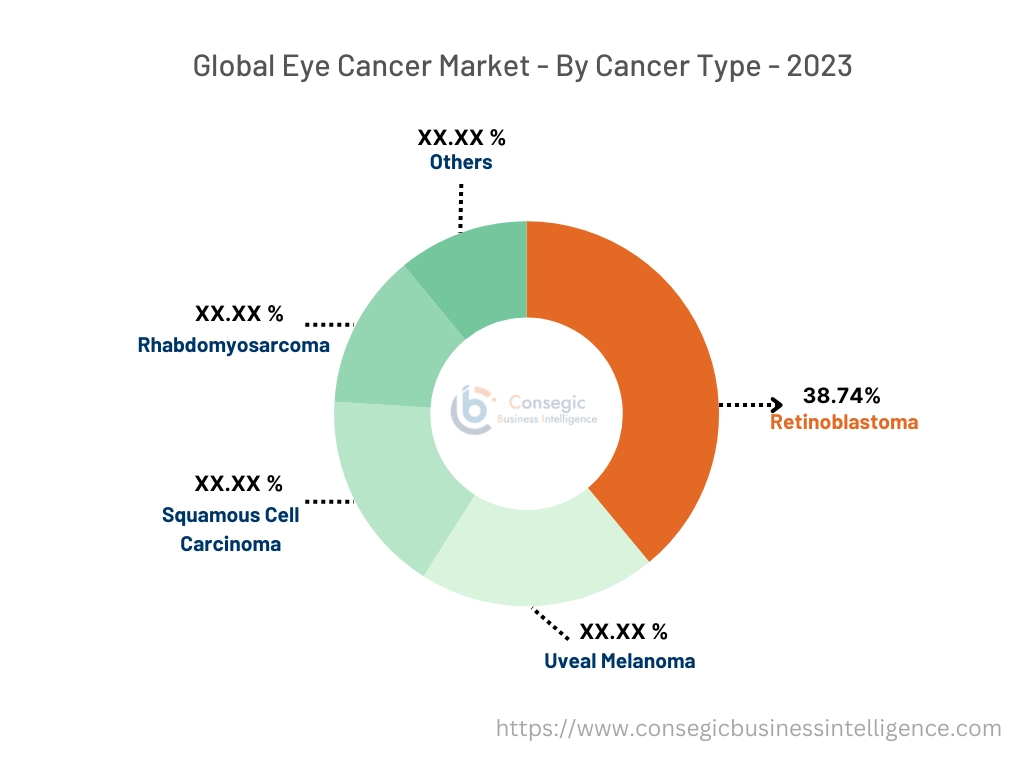
By Treatment Type:
Based on treatment type the market is segmented into Surgery, Radiation Therapy, Chemotherapy, Targeted Therapy, Immunotherapy, and others.
Trends in the Treatment Type:
- Ongoing advancements in surgical techniques and technology, such as minimally invasive procedures and improved surgical tools, enhance treatment outcomes.
The surgery application accounted for the largest revenue of the total eye cancer market share in 2023.
- Surgical interventions, such as enucleation (removal of the eye) or more conservative procedures like cryotherapy or laser therapy, are crucial for managing eye cancers, leading to substantial revenue in this segment.
- Advanced surgical techniques and technologies, such as intraoperative imaging and robotic-assisted surgery, drive up the overall cost.
- Reconstructive procedures, such as orbital implants or prosthetic eyes, and follow-up surgeries for cancer management contribute to the overall revenue from surgical interventions.
- For instance, Macmillan Cancer Support states that conjunctival melanoma is most often treated with surgery. They employ a procedure known as cryotherapy. This freezes any cancer cells that may still be present, eventually destroying them.
- Thus, the surgery application reflects its critical role in treating various types of cancer, the complexity, and cost of procedures, hence boosting the eye cancer market growth.
The immunotherapy segment is anticipated to register the fastest CAGR during the forecast period.
- Recent advancements in immunotherapy, such as checkpoint inhibitors, CAR-T cell therapy, and immune modulators, have shown promising results in clinical trials for various cancers.
- Immunotherapy involves personalized approaches tailored to individual patient's genetic and molecular profiles. This approach leads to more effective and targeted treatments.
- An increase in clinical trials focused on immunotherapy for eye cancer is accelerating the development and adoption of these treatments.
- For instance, anti-PDL-1 drugs like pembrolizumab or nivolumab are used in immunotherapy to treat some tumors that have the antigen PD-L1.
- Thus, the immunotherapy segment is driven by its innovative approach, advancements in treatment, personalized medicine, positive clinical outcomes, and high unmet medical needs, in turn, driving the eye cancer market trends.
By Diagnosis:
Based on diagnosis the market is segmented into Biopsy, Ultrasound, CT scan/MRI, Fluorescein Angiography, and others.
Trends in the Diagnosis:
- Advancements in biopsy technologies, such as image-guided biopsies and molecular profiling, have improved the accuracy and effectiveness of biopsy procedures.
The biopsy application accounted for the largest revenue share in 2023.
- Biopsy involves extracting a sample of tissue from the eye or surrounding area to be examined microscopically. This makes it a key component of cancer management and contributes to its significant revenue share.
- Different biopsy techniques, including fine needle aspiration (FNA), core needle biopsy, and incisional biopsy, are used depending on the location and type of eye cancer.
- Specialized centers and clinics that focus on cancer diagnosis and treatment often have high volumes of biopsy procedures.
- For instance, MD Anderson performs biopsies to determine what type of cancer treatments someone is eligible for and also to personalize the patients' care plans.
- Thus, the integration of biopsy results with treatment planning, increased awareness, and specialized centers further contribute to the significant revenue generated by this application.
The CT scan/MRI segment is anticipated to register the fastest CAGR during the forecast period.
- Recent advancements in CT and MRI technologies have significantly improved their resolution and diagnostic capabilities. Enhanced imaging techniques allow for better visualization of eye tumors, leading to increased adoption of these modalities in clinical practice.
- Both CT and MRI are non-invasive imaging techniques that provide detailed information about the tumor's size, location, and involvement with surrounding structures.
- Healthcare providers and patients often prefer advanced imaging techniques like CT and MRI for their accuracy and detailed diagnostic information.
- For instance, GE Healthcare reports state that the growing trend of MRI-only radiation therapy is being supported by new AI tools in MRI that enable radiation oncologists to create synthetic CT images from MRI data.
- Thus, the CT scan/MRI segment is driven by the need for early and accurate diagnosis, technological innovations, and the rising incidence of eye cancer.
By End-User:
Based on end-user the market is segmented into Hospitals, Specialty Clinics, Ambulatory Surgical Centres, and others.
Trends in the End-User:
- Hospitals invest heavily in advanced technology and highly skilled medical professionals. The ability to offer cutting-edge treatments and expertise in managing complex cases attracts patients and drives revenue.
- Specialty clinics often adopt and offer the latest advancements in treatment technologies and techniques more rapidly than general hospitals.
The hospitals segment accounted for the largest revenue share in 2023.
- Hospitals are typically the primary setting for the diagnosis, treatment, and management of eye cancer. They offer a range of specialized services, including advanced diagnostic imaging, surgical interventions, chemotherapy, and radiation therapy.
- Hospitals provide multidisciplinary care, including input from oncologists, ophthalmologists, radiologists, and pathologists.
- Hospitals often collaborate with pharmaceutical companies, research institutions, and other healthcare providers, leading to additional revenue streams from partnerships and joint ventures focused on cancer treatments.
- For instance, UT Southwestern's ocular oncologists utilize advanced technology and top treatment options to provide the most effective treatment plan for each cancer patient.
- Thus, the comprehensive services and advanced technology available in hospitals make them a key players in the management and treatment of cancer, driving significant eye cancer market opportunities.
The specialty clinics segment is anticipated to register the fastest CAGR during the forecast period.
- Innovations such as targeted therapies, advanced imaging techniques, and novel surgical procedures are frequently available at specialty clinics, attracting patients seeking cutting-edge care.
- Shorter wait times, specialized diagnostic procedures, and dedicated treatment protocols attract patients who prioritize efficiency and specialized care.
- Many specialty clinics are involved in research and clinical trials focused on eye cancer, leading to the adoption of innovative therapies and practices. Participation in research often positions these clinics as leaders in their field, driving demand for their services.
- For instance, as per Cleveland Clinique intraocular melanomas are by far the most common form of eye cancer. Approximately 2,500 people receive this diagnosis each year.
- Thus, as per the analysis, their role in providing specialized, cutting-edge care and participating in research further supports their rapid growth in the eye cancer market trends.
Regional Analysis:
The regions covered are North America, Europe, Asia Pacific, the Middle East and Africa, and Latin America.
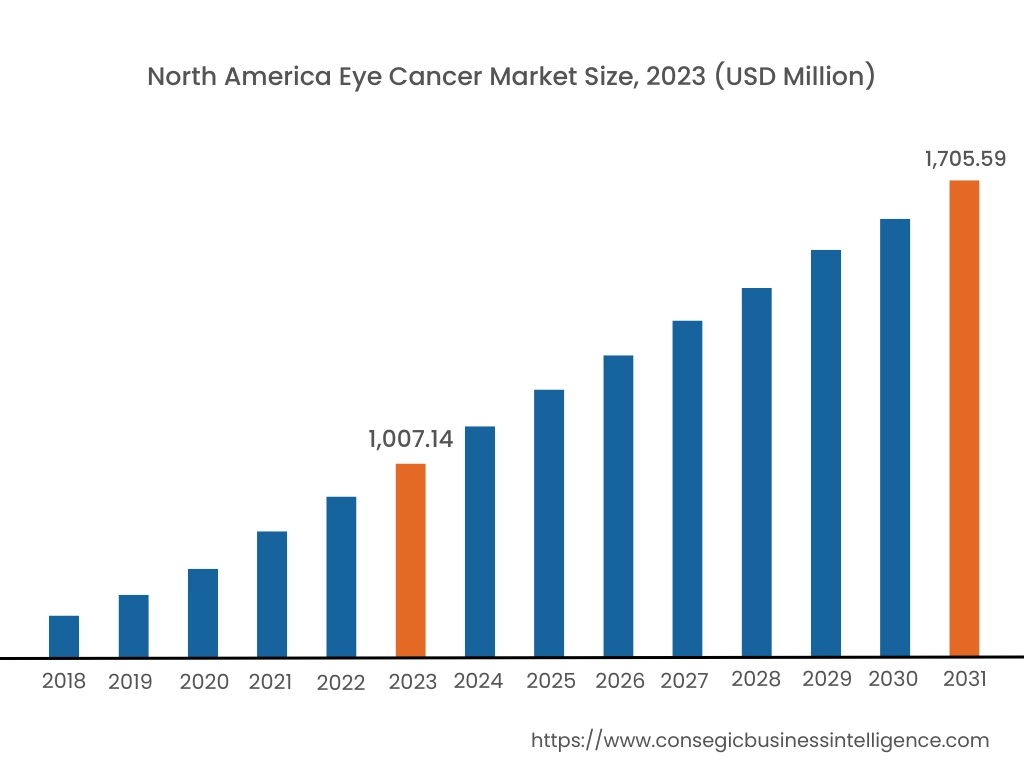
In 2023, North America accounted for the highest market share at 37.65% and was valued at USD 1,007.14 million, and is expected to reach USD 1,705.59 million in 2031. In North America, the U.S. accounted for the highest market share of 68.75% during the base year of 2023.
North America, particularly the United States and Canada, holds a substantial share of the global eye cancer market. This dominance is driven by advanced healthcare infrastructure, high levels of research and development, and a large patient population. This increases the eye cancer market expansion in the region.
- In August 2022, Cleveland Clinique stated that eye cancer is extremely rare and only about 3,400 people in the United States receive an eye cancer diagnosis each year.
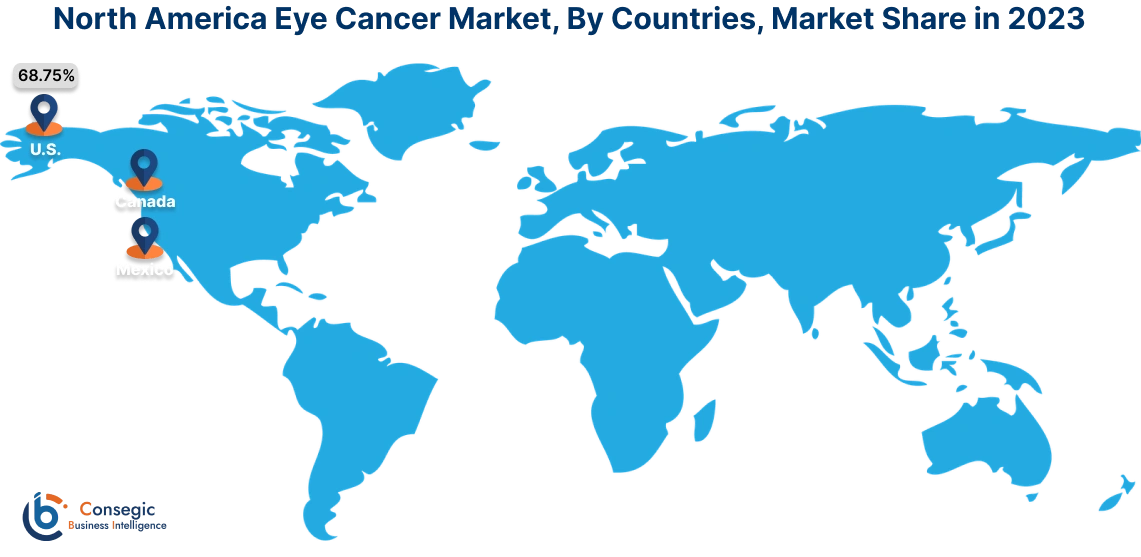
The eye cancer market analysis in the Asia-Pacific region, the market is characterized by rapid growth and significant opportunities due to a combination of increasing incidence rates, evolving healthcare infrastructure, and rising awareness.
- In October 2023, the 13th Asia-Pacific Eye Care Week, held in conjunction with World Sight Day on October 12 provided free eye screenings and cataract surgeries, while members of the community from young to old were informed of crucial eye care.
The market in Europe is expected to grow due to rising incidence rates, advancements in treatment technologies, and increased investment in healthcare. The eye cancer market analysis in the Middle East and Africa region shows that the market is evolving, with significant potential and unique challenges. There is increasing interest in cancer research and development, supported by both governmental and private investments. The eye cancer market expansion in Latin America is seeing steady growth, driven by the adoption of advanced diagnostic and therapeutic technologies and improvements in healthcare infrastructure.
Top Key Players & Market Share Insights:
The eye cancer market is highly competitive with major players providing cures and treatments to the national and international markets. Key players are adopting several strategies in research and development (R&D), product innovation, and end-user launches to hold a strong position in the global eye cancer market. Key players in the eye cancer industry include-
- Sanofi (France)
- Bayer AG (Germany)
- Pfizer Inc. (U.S.)
- Spectrum Pharmaceuticals Inc. (U.S.)
- Bristol-Myers Squibb Company (U.S.)
- Immunomedics (U.S.)
- Novartis AG (Switzerland)
- AbbVie Inc. (U.S.)
- Janssen Biotech, Inc. (U.S.)
- AstraZeneca Plc. (U.K.)
- F. Hoffmann-La Roche Ltd. (Switzerland)
- Eli Lilly and Company (U.S.)
- Takeda Pharmaceuticals (Japan)
- GlaxoSmithKline Plc. (U.K.)
- Amgen, Inc. (U.S.)
- Merck & Co., Inc. (U.S.)
- Oncomed Pharmaceuticals (U.S.)
Recent Industry Developments :
Product Launch:
- In March 2024, Roche launches Vabysmo, a best-selling eye medication, in India. The medication is reasonably priced and works with the government and insurance providers to facilitate patient access.
Partnerships and Collaborations:
- In March 2024, The International Ophthalmological Fellowship Foundation (IOFF) and the Ophthalmology Foundation (OF) partnered with the ECF. The goal of this relationship is to increase the capacity of both organizations to train eye cancer specialists for underdeveloped and neglected nations.
Merges and Acquisitions:
- In March 2024, Fusion Pharmaceuticals Inc., a clinical-stage biopharmaceutical business creating next-generation radio-conjugates, reached a definitive agreement to be acquired by AstraZeneca.
Eye Cancer Market Report Insights :
| Report Attributes | Report Details |
| Study Timeline | 2018-2031 |
| Market Size in 2031 | USD 2,675.00 Million |
| CAGR (2024-2031) | 7.6% |
| By Cancer Type |
|
| By Treatment Type |
|
| By Diagnosis |
|
| By End-User |
|
| By Region |
|
| Key Players |
|
| North America | U.S. Canada Mexico |
| Europe | U.K. Germany France Spain Italy Russia Benelux Rest of Europe |
| APAC | China South Korea Japan India Australia ASEAN Rest of Asia-Pacific |
| Middle East and Africa | GCC Turkey South Africa Rest of MEA |
| LATAM | Brazil Argentina Chile Rest of LATAM |
| Report Coverage |
|
Key Questions Answered in the Report
How big is the Eye Cancer Market? +
Eye Cancer Market size is growing with a CAGR of 7.6% during the forecast period (2024-2031), and the market is projected to be valued at USD 2,675.00 Million by 2031 from USD 4,459.06 Million in 2023.
Which is the fastest-growing region in the eye cancer market? +
The fastest-growing region in the eye cancer market is Asia-Pacific.
What specific segmentation details are covered in the eye cancer market report? +
The specific segments that are covered in the eye cancer market are cancer type, treatment type, diagnosis, and end-user.
Who are the major players in the eye cancer market? +
The major players in the eye cancer market are Sanofi (France), Spectrum Pharmaceuticals Inc. (U.S.), Bayer AG (Germany), and AstraZeneca Plc. (U.K.), Bristol-Myers Squibb Company (U.S.), Immunomedics (U.S.), Eli Lilly and Company (U.S.), Takeda Pharmaceuticals (Japan), GlaxoSmithKline Plc. (U.K.), F. Hoffmann-La Roche Ltd. (Switzerland), Amgen, Inc. (U.S.), Novartis AG (Switzerland), AbbVie Inc. (U.S.), Janssen Biotech, Inc. (U.S.), Pfizer, Inc. (U.S.), Merck & Co., Inc. (U.S.), and Oncomed Pharmaceuticals (U.S.).
